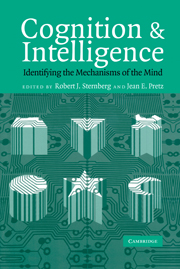Book contents
- Frontmatter
- Contents
- Preface
- 1 Information Processing and Intelligence: Where We Are and Where We Are Going
- 2 Mental Chronometry and the Unification of Differential Psychology
- 3 Reductionism versus Charting: Ways of Examining the Role of Lower-Order Cognitive Processes in Intelligence
- 4 Basic Information Processing and the Psychophysiology of Intelligence
- 5 The Neural Bases of Intelligence: A Perspective Based on Functional Neuroimaging
- 6 The Role of Working Memory in Higher-Level Cognition: Domain-Specific versus Domain-General Perspectives
- 7 Higher-Order Cognition and Intelligence
- 8 Ability Determinants of Individual Differences in Skilled Performance
- 9 Complex Problem Solving and Intelligence: Empirical Relation and Causal Direction
- 10 Intelligence as Smart Heuristics
- 11 The Role of Transferable Knowledge in Intelligence
- 12 Reasoning Abilities
- 13 Measuring Human Intelligence with Artificial Intelligence: Adaptive Item Generation
- 14 Marrying Intelligence and Cognition: A Developmental View
- 15 From Description to Explanation in Cognitive Aging
- 16 Unifying the Field: Cognition and Intelligence
- Author Index
- Subject Index
- References
4 - Basic Information Processing and the Psychophysiology of Intelligence
Published online by Cambridge University Press: 23 November 2009
- Frontmatter
- Contents
- Preface
- 1 Information Processing and Intelligence: Where We Are and Where We Are Going
- 2 Mental Chronometry and the Unification of Differential Psychology
- 3 Reductionism versus Charting: Ways of Examining the Role of Lower-Order Cognitive Processes in Intelligence
- 4 Basic Information Processing and the Psychophysiology of Intelligence
- 5 The Neural Bases of Intelligence: A Perspective Based on Functional Neuroimaging
- 6 The Role of Working Memory in Higher-Level Cognition: Domain-Specific versus Domain-General Perspectives
- 7 Higher-Order Cognition and Intelligence
- 8 Ability Determinants of Individual Differences in Skilled Performance
- 9 Complex Problem Solving and Intelligence: Empirical Relation and Causal Direction
- 10 Intelligence as Smart Heuristics
- 11 The Role of Transferable Knowledge in Intelligence
- 12 Reasoning Abilities
- 13 Measuring Human Intelligence with Artificial Intelligence: Adaptive Item Generation
- 14 Marrying Intelligence and Cognition: A Developmental View
- 15 From Description to Explanation in Cognitive Aging
- 16 Unifying the Field: Cognition and Intelligence
- Author Index
- Subject Index
- References
Summary
BASIC INFORMATION PROCESSING AND INTELLIGENCE
Research on individual differences in human cognitive abilities or intelligence has a long history in scientific psychology. After decades of psychometric research into the structure of human cognitive abilities, the last 20 to 30 years have been characterized also by attempts to analyze cognitive components and correlates of psychometric intelligence. In this realm an important approach has been the attempt to relate the individual speed of information processing to psychometric intelligence (the so-called mental speed approach). This approach traces back to the idea that human cognitive or intellectual functioning might be decomposed in elementary cognitive processes, which are assumed to constitute an important basis of intellectual functioning. In the last two decades important progress has been made in this field of research: In using so-called elementary cognitive tasks (ECTs), which put only minimal requirements on the participants and are, thus, less likely prone to differential strategy usage, dozens of studies have provided converging evidence that shorter reaction times in these tasks are associated with higher psychometric intelligence, indicating a higher speed of information processing in brighter individuals.
The ECTs that have been used most extensively in this field of research are the Hick and the inspection time (IT) paradigm (see Fig. 1a). In the IT paradigm (cf. Vickers, Nettelbeck, & Wilson, 1972) participants are tachistoscopically (i.e., for very short exposure durations) shown two vertical lines of different length. Immediately after their exposure, the lines are masked by two thicker vertical lines of equal length.
- Type
- Chapter
- Information
- Cognition and IntelligenceIdentifying the Mechanisms of the Mind, pp. 68 - 87Publisher: Cambridge University PressPrint publication year: 2004
References
- 1
- Cited by

